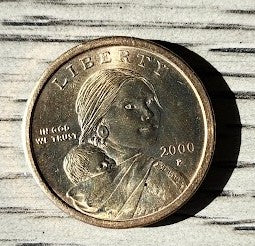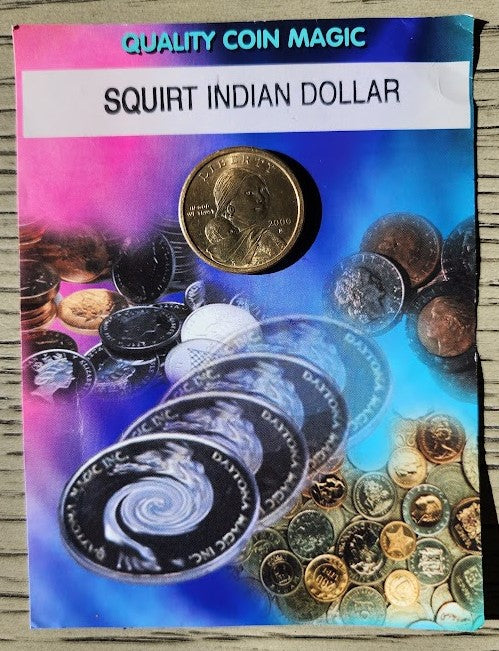1
/
of
2
Trunk Of Magic
The Squirting Dollar Coin (Squirt Indian Dollar)
The Squirting Dollar Coin (Squirt Indian Dollar)
Regular price
$8.00
Regular price
$10.00
Sale price
$8.00
Unit price
/
per
Shipping calculated at checkout.
Couldn't load pickup availability
The United States Congress has passed a law authorizing the United States Mint to place into circulation a new dollar coin, similar in size to the Susan B. Anthony dollar coin, golden in color, and with a distinctive edge. The U.S. Treasury department has announced that the woman on that this dollar coin will be a representation of Liberty as Sacagawea, the Shoshoni Indian woman who helped guide the Lewis and Clark Expedition to the northwest. That her fame is somewhat deserving is evident from historical records. However, disparities exist in everything from the spelling of her name to the dates of both her birth and death. Sacagawea has become romanticized over time and her actual accomplishments have been revised in legend.
Lewis and Clark identified Sacagawea, (and spelled it with a "g" - not a "j") in their journals, as a woman of the "Snake" Nation (Shoshoni) who had been captured and enslaved by the Hidatsa Indians of Knife River, North Dakota. They first met her in November 1804 at their Fort Mandan winter headquarters. At the time she was about seventeen years old and pregnant by French-Canadian fur trader, Toussaint Charbonneau, who often resided among the Hidatsa Indians and had purchased Sacagawea from them.
Charbonneau, who was conversant in French and Hidatsa, and Sacagawea, who spoke both Shoshoni and Hidatsa, were hired as interpreters by Lewis and Clark.
Sacagawea gave birth to a son -Jean Baptiste Charbonneau at Fort Mandan, February 11, 1805. Clark nicknamed the baby "Pomp" or "Pompy", and decided that the baby could accompany his parents on the journey to the Pacific and back in 1805 and 1806. Lewis and Clark recognized that Sacagawea could make a significant contribution to the party if it encountered the Shoshonis when it reached her homeland in the mountains. They also felt that by traveling with an Indian woman and baby that hostile Indians would not see them as a threat but as a peaceful expedition. Sacagawea proved her usefulness as an interpreter among her own people, negotiating for horses needed by the explorers to cross the mountains.
As you know from your history the journey took almost two years and the exploration party encountered harsh weather, steep mountain trails, and the roughest of conditions. Sacagawea endured all of this while carrying and tending to an infant son - which is in itself amazing. She was never compensated for her service - though Charbonneau was paid for his. When the trip was over they were "dismissed" from the expedition at Fort Mandan. And it is after this that history becomes obscured.
Disputes have circulated for decades concerning Sacagawea's life after the expedition, particularly with respect to the time and place of her death. One theory that evolved says that she died April 9, 1884, and was buried at Fort Washakie, Wind River Indian Reservation, Wyoming. On the other hand documentary evidence is supposed to exist that traces a complete chronology of her life, conclusively placing her at Fort Manuel South Dakota at the time of her death, December 20, 1812.
Whatever the facts are - legend spinners will always modify history in some way - if only to make it more interesting. At least in the next century Sacagawea - a woman of indomitable achievement will be recognized once more for her contributions to the shaping of America.
Now that you know all about Sacagawea and her son Pompy, have some fun. Ask someone if they have seen the new dollar coin. Ask them if they know the name of the person on the coin. Tell them if they don't. Ask them if they know the name of her baby. Tell them if they don't. Ask if they know whether her baby is a boy or girl. Tell them to look close at the coin and they can tell. GIVE THEM A SQUIRT!
Lewis and Clark identified Sacagawea, (and spelled it with a "g" - not a "j") in their journals, as a woman of the "Snake" Nation (Shoshoni) who had been captured and enslaved by the Hidatsa Indians of Knife River, North Dakota. They first met her in November 1804 at their Fort Mandan winter headquarters. At the time she was about seventeen years old and pregnant by French-Canadian fur trader, Toussaint Charbonneau, who often resided among the Hidatsa Indians and had purchased Sacagawea from them.
Charbonneau, who was conversant in French and Hidatsa, and Sacagawea, who spoke both Shoshoni and Hidatsa, were hired as interpreters by Lewis and Clark.
Sacagawea gave birth to a son -Jean Baptiste Charbonneau at Fort Mandan, February 11, 1805. Clark nicknamed the baby "Pomp" or "Pompy", and decided that the baby could accompany his parents on the journey to the Pacific and back in 1805 and 1806. Lewis and Clark recognized that Sacagawea could make a significant contribution to the party if it encountered the Shoshonis when it reached her homeland in the mountains. They also felt that by traveling with an Indian woman and baby that hostile Indians would not see them as a threat but as a peaceful expedition. Sacagawea proved her usefulness as an interpreter among her own people, negotiating for horses needed by the explorers to cross the mountains.
As you know from your history the journey took almost two years and the exploration party encountered harsh weather, steep mountain trails, and the roughest of conditions. Sacagawea endured all of this while carrying and tending to an infant son - which is in itself amazing. She was never compensated for her service - though Charbonneau was paid for his. When the trip was over they were "dismissed" from the expedition at Fort Mandan. And it is after this that history becomes obscured.
Disputes have circulated for decades concerning Sacagawea's life after the expedition, particularly with respect to the time and place of her death. One theory that evolved says that she died April 9, 1884, and was buried at Fort Washakie, Wind River Indian Reservation, Wyoming. On the other hand documentary evidence is supposed to exist that traces a complete chronology of her life, conclusively placing her at Fort Manuel South Dakota at the time of her death, December 20, 1812.
Whatever the facts are - legend spinners will always modify history in some way - if only to make it more interesting. At least in the next century Sacagawea - a woman of indomitable achievement will be recognized once more for her contributions to the shaping of America.
Now that you know all about Sacagawea and her son Pompy, have some fun. Ask someone if they have seen the new dollar coin. Ask them if they know the name of the person on the coin. Tell them if they don't. Ask them if they know the name of her baby. Tell them if they don't. Ask if they know whether her baby is a boy or girl. Tell them to look close at the coin and they can tell. GIVE THEM A SQUIRT!
Share








